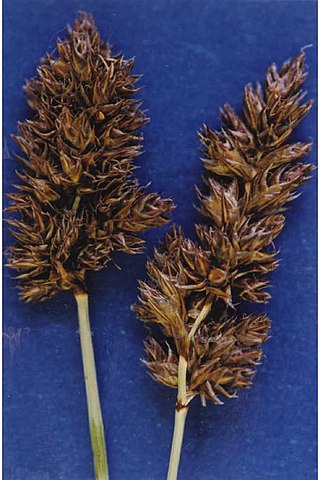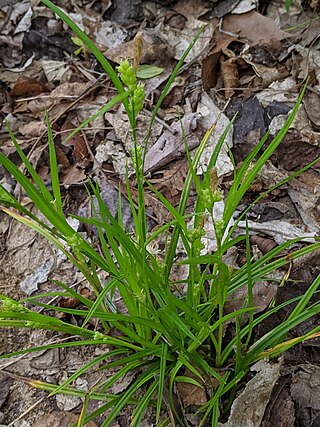Carex alma is a species of sedge known by the common name sturdy sedge. It is native to the southwestern United States and northern Mexico, where it grows in moist spots in a number of habitat types. This sedge forms a thick clump of thin stems up to 90 centimeters in length and long, thready leaves. The leaves have basal sheaths with conspicuous red coloration, often spotting. The inflorescence is a dense to open cluster of many spikelets occurring both at the ends of stems and at nodes. Each cluster is up to 15 centimeters long and 1 to 2 wide. The plant is sometimes dioecious, with an individual sedge bearing either male or female flowers. The female, pistillate flowers have white or white-edged bracts. The male, staminate flowers have visible anthers 2 millimeters long or longer. The fruit is coated in a sac called a perigynium which is gold to dark brown in color and has a characteristic bit of spongy tissue at the base.

Carex leptalea is a species of sedge known by the common names bristly-stalked sedge and flaccid sedge. It is native to much of North America including most of Canada, the Dominican Republic, and the United States. It only grows in wetlands. This sedge produces dense clusters of thin stems up to 70 centimeters tall from a network of branching rhizomes. The thin, deep green leaves are soft, hairless, and sometimes drooping. The inflorescence is up to 16 millimeters long but only 2 to 3 millimeters wide, and is yellow-green in color. There are only a few perigynia on each spikelet, and they are green and veined.
- Carex leptalea subsp. harperi(Fernald) W.Stone - southeastern US from Texas and Florida north to Missouri and Pennsylvania
- Carex leptalea subsp. leptalea - widespread from Alaska east to Nunavut and south to California and Dominican Republic
- Carex leptalea subsp. pacificaCalder & Roy L.Taylor - Washington State, British Columbia, southeastern Alaska

Carex simulata is a species of sedge known by the common name analogue sedge.

Carex pensylvanica is a species of flowering plant in the sedge family commonly called Pennsylvania sedge. Other common names include early sedge, common oak sedge, and yellow sedge.
Carex klamathensis is a rare species of sedge known by the common name Klamath sedge. It is known from 15 or fewer populations in southern Oregon and three populations in the Klamath Region of northern California. It was described to science only in 2007. Its habitat includes fens and other wet habitat, on serpentine soils. It was discovered independently by botanists Peter Zika and Lawrence Janeway.

Carex distans, commonly known as distant sedge, is a plant species in the sedge family, Cyperaceae. It is native to Europe and North Africa. It is part of a complex of similar species that occur across Eurasia. Its relatives include Carex diluta of central Asia, which has also introduced to North America in Montana. C. distans has been introduced to US states including Maryland and Pennsylvania. More recently, it was found in Oregon. There is a report from Victoria, Australia as well.

Carex lacustris, known as lake sedge, is a tufted grass-like perennial of the sedge family (Cyperaceae), native to southern Canada and the northern United States. C. lacustris us an herbaceous surface-piercing plant that grows in water up to 50 cm (1.6 ft) deep, and grows 50–150 cm (1.6–4.9 ft) tall. It grows well in marshes and swampy woods of the boreal forest, along river and lake shores, in ditches, marshes, swamps, and other wetland habitat. It grows on muck, sedge peat, wet sand or silt, in filtered or full sunlight.

Carex eburnea, known as ivory sedge, ebony sedge, and bristleleaf or bristle-leaved sedge, is a small and slender sedge native to North America, from Alaska and Newfoundland south to central Mexico.

Carex sprengelii, known as Sprengel's sedge and long-beaked sedge, is a sedge with hanging seed heads, native to North America.

Carex blanda, the common woodland sedge or eastern woodland sedge, is a species of sedge native to a wide variety of habitats in the eastern and central United States and Canada.

Carex davisii, known as Davis' sedge or awned graceful sedge, is a species of Carex native to North America. It is listed as an endangered, threatened, or species of concern across much of edge of its range. It was named in the 1820s by Lewis David de Schweinitz and John Torrey in honor of Emerson Davis (1798–1866), a Massachusetts educator and "enthusiastic student of the genus" Carex.

Carex brevior, known as shortbeak sedge and plains oval sedge, is a species of sedge native to North America. The specific epithet brevior means "shorter" in Latin.
Carex arctogena is a member of the sedge family (Cyperaceae) which grows in high alpine areas. It is one of the few "bipolar" species; it has populations in Greenland, Scandinavia, Russia, Canada and southern South America. Plants in the far north and south appear to be genetically identical, having taken advantage of a similar niches on opposite ends of the globe.

Carex bicolor, the bicoloured sedge, is a species of sedge native to North America, Northern Europe and Northern Asia. The International Union for Conservation of Nature has assessed the plant's conservation status as being of least concern because it has a widespread distribution and faces no particular threats.

Carex baileyi is a sedge in section Vesicariae the genus Carex native to the Appalachian mountains in Eastern North America. It is commonly called Bailey's sedge. Carex baileyi was named in honor of Liberty Hyde Bailey by its discoverer, Nathaniel_Lord_Britton.
Carex bella is a tussock-forming species of perennial sedge in the family Cyperaceae. It is native to parts of the United States and Mexico, including California, Arizona, New Mexico, Utah, Colorado, Wyoming, and South Dakota in the United States, and Nuevo Leon in Mexico. It's common names are the Showy sedge, and the Southwestern Showy sedge.
Carex ozarkana, the Ozark sedge, is a species of flowering plant in the family Cyperaceae, native to the U.S. states of Oklahoma, Texas, Arkansas, and Louisiana.

Carex bullata is a tussock-forming species of perennial sedge in the family Cyperaceae. It is native to south eastern parts of Canada and eastern parts of the United States. It has the common name of the button sedge.
Carex godfreyi is a tussock-forming species of perennial sedge in the family Cyperaceae. It is native to south eastern parts of the United States. It's common name is Godfrey's sedge.
Carex adelostoma is a tussock-forming species of perennial sedge in the family Cyperaceae. It is native to the subarctic areas, including Scandinavia, Russia, Canada, and Alaska. A common name is circumpolar sedge.














